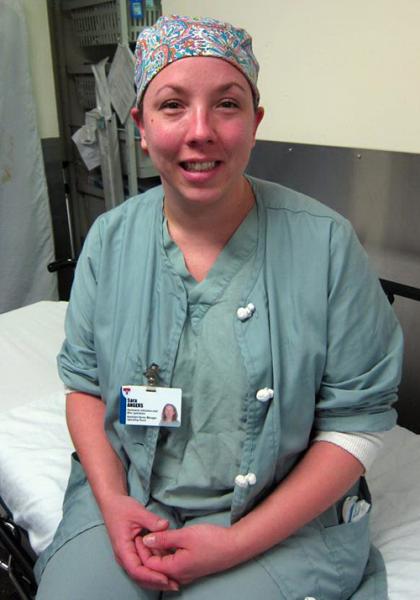Meet Operating Room Nurse: Sara Angers
 From the age of four, when she was admitted to the hospital with meningitis for two weeks, Sara Angers wanted to be a nurse.
From the age of four, when she was admitted to the hospital with meningitis for two weeks, Sara Angers wanted to be a nurse.
Her lifelong dream came true when she was accepted into nursing at Dawson and then while interning on Surgical 9 West of the Royal Victoria Hospital (RVH) she was offered a job. Ms. Angers has been at the MUHC for 12 years, 10 of which have been spent in the Operating Room (OR).
“It was during my internship when I got the OR bug,” says Ms. Angers, who has a 7-year-old daughter and is studying part-time for her bachelors degree. “When they scrubbed me in, I thought it was the coolest thing in the world and I was very impressed by how well everyone worked together.”
At the MUHC, nurses are trained on the job to work in the OR. It takes approximately one year to become familiar with the eight specialities, which include Cardiac, Vascular, Gynecology/urology, ENT, Ophthalmology, Plastics, General Surgery, Hepaticobiliary/Transplant. “Not many hospitals do this,” says Ms. Angers, who mostly works with vascular and plastics but sometimes she will step in for other surgeries.
“With Plastics we are involved in reconstructive surgery for cancer patients, mainly breast, and birth defects or abnormalities. We also do BAHA Cochlear hearing implants,” says Ms. Angers, who also oversees material management; making sure all supplies for all the surgeries are stocked. “Vascular includes removing plaque out of the carotid artery and arteries in the legs; amputations; and we do abdominal aortic repair.”
According to Ms. Angers, some of the most attractive points about being an OR nurse include not working on a 24/7 schedule, like a regular floor, so nurses do more day shifts and less weekends. Also, if there are 12 statutory holidays in the year, of those a nurse may work only four of them. And during the Holiday Season and New Years, OR nurses work just one every other year.
They are also constantly evolving their technology and skill-sets. One way this is achieved is by holding a teaching class once a week for an hour on one subject, such as learning how to use new equipment. They also attend conferences.
But perhaps at the top of Ms. Angers list is the well-oiled machine-like teamwork.
“A lot of my actions as an OR nurse require planning and coordinating with the surgeons. Every action has a reaction and you have to know what you are doing as you have someone’s life in your hands. I am the patient’s advocate in that room—he or she is my priority.”
Ms. Angers says communication is the most important part of working in the OR as a team—of which, 90 per cent she estimates is verbal. For a nurse with experience he/she learns to react to cues from the surgeon, such as body language or tone of voice.
Along with nurses and surgeons in the OR, there are anaesthesiologists, respiratory therapists, residents, medical and nursing students, PABs and housekeepers.
Ms. Angers says the teams in the ORs are a good family. “We really support each other and we take time to have social activities,” she says. “This contributes to our very cohesive relationship, which I think contributes to best care for our patients and families.”
